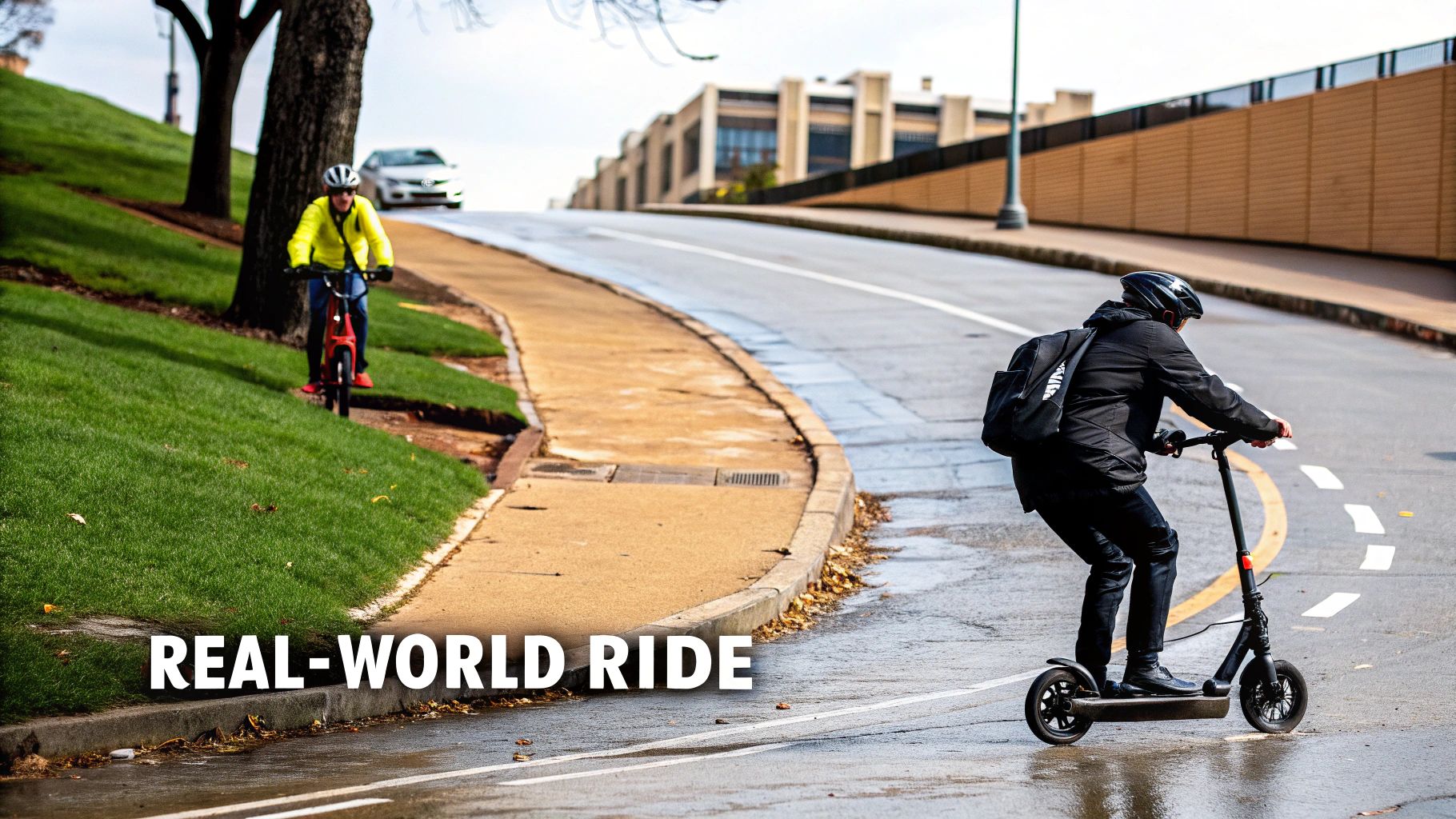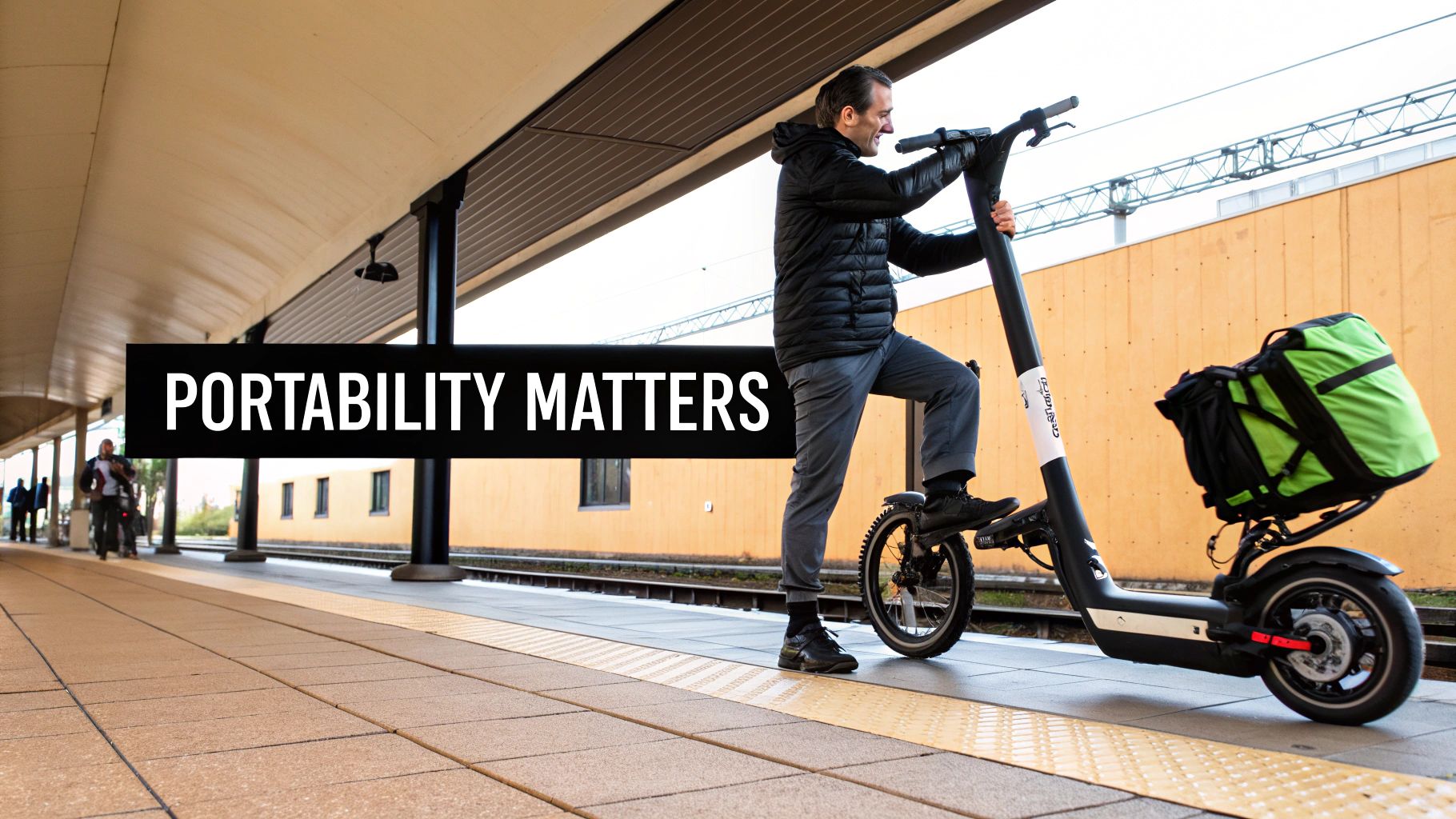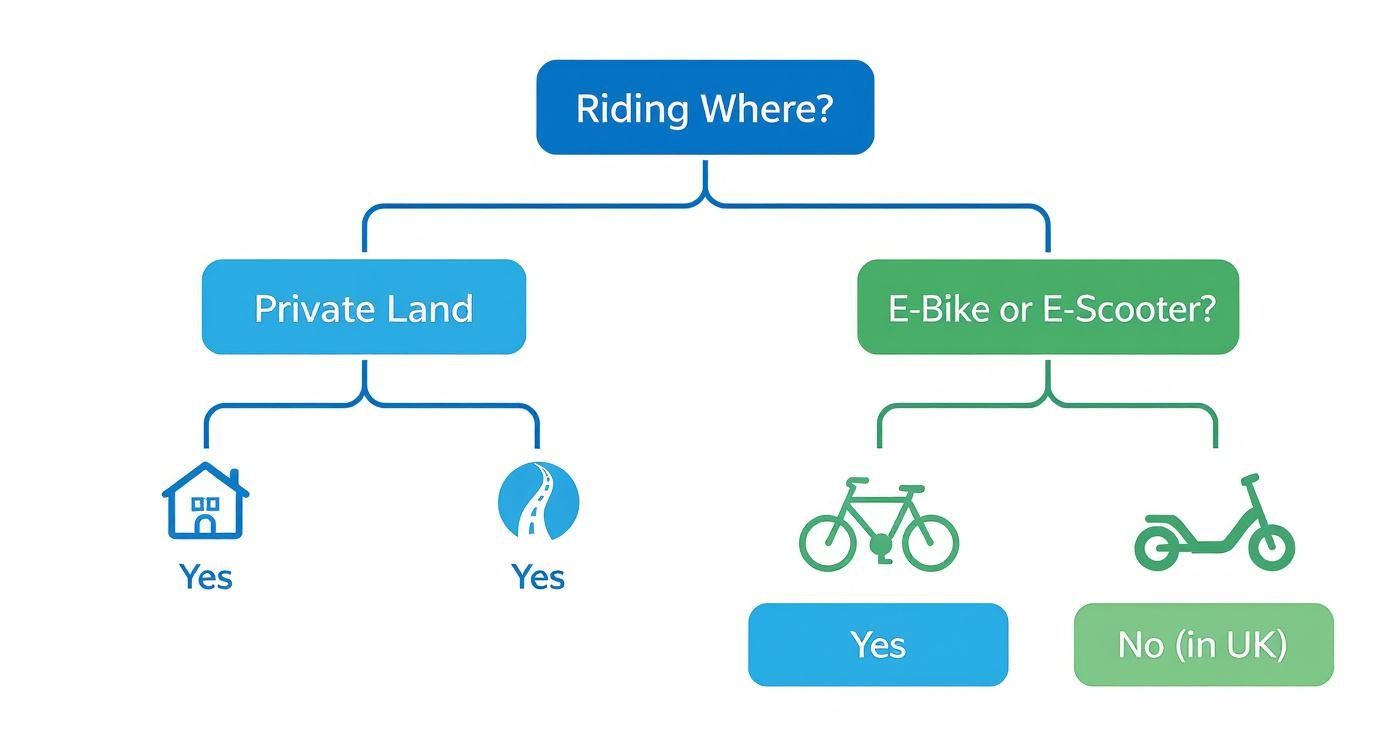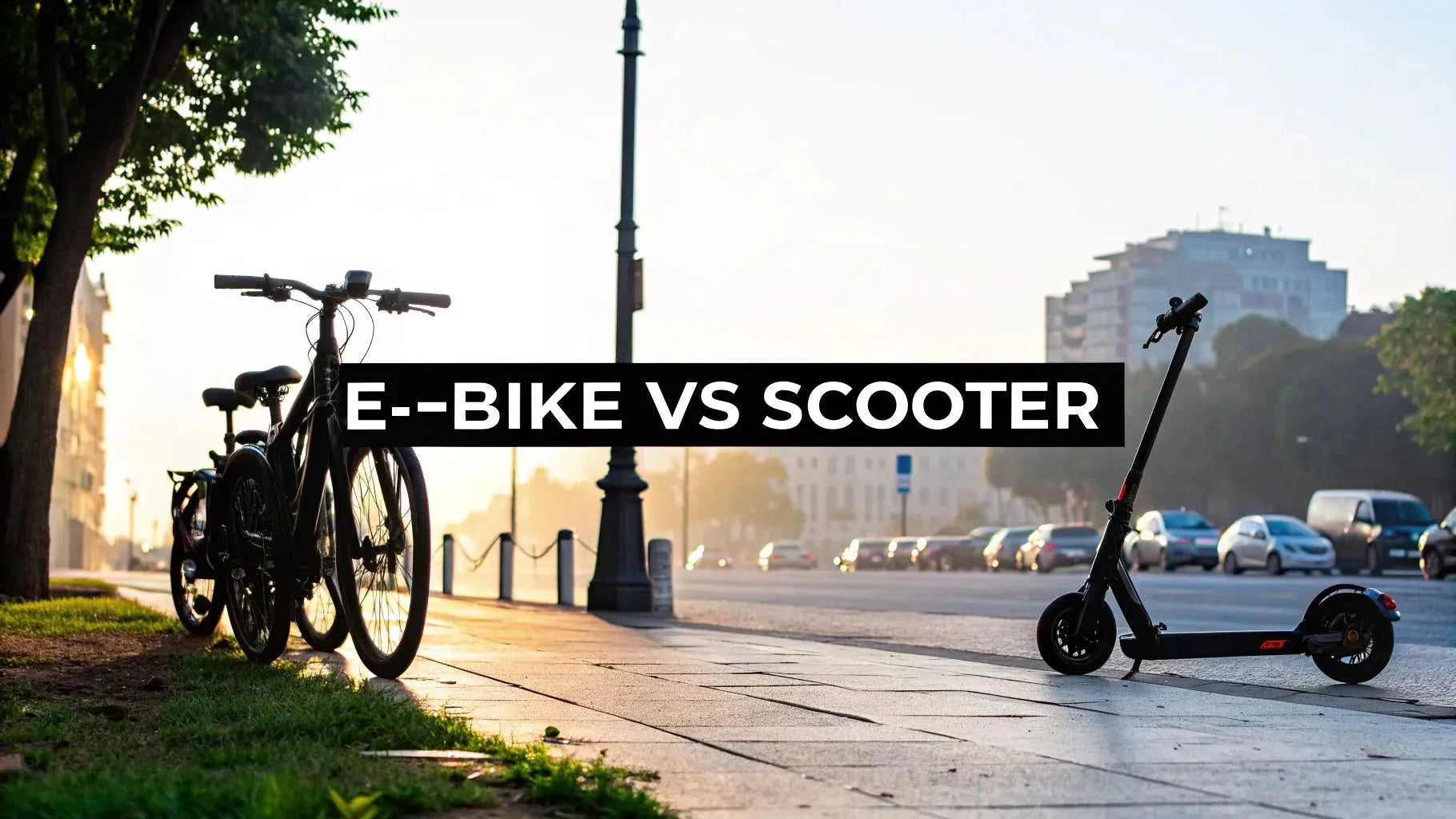When you're trying to decide between an electric bike and an electric scooter, it boils down to one simple question: what does your daily commute actually look like? E-bikes are the clear winner for stability, range, and tackling longer or hillier routes. E-scooters, on the other hand, are all about unmatched portability for those short, last-mile dashes.
It's a classic tradeoff: do you value ride quality and a bit of a workout, or is grab-and-go convenience your top priority?
Your Commuting Companion: The Ultimate Showdown
Picking the right electric ride can genuinely transform your daily travel. Both e-bikes and e-scooters offer a way to get around that's cheaper, greener, and often way faster than being stuck in a car or waiting for a bus. But they offer completely different experiences, and what works for one person might be a total miss for another.
Let's cut through the hype and figure out which one is the right fit for you.

Before we get into the nitty-gritty details, a quick overview can help frame the decision. Think of this table as the cheat sheet for your commute. We'll explore all the nuances later, but this gives you a solid starting point.
At-a-Glance: E-Bike vs. E-Scooter Commuting
Here’s a quick breakdown of the most important factors, keeping the practical realities for commuters in mind.
| Factor | Electric Bike | Electric Scooter |
|---|---|---|
| Ideal Commute | Longer trips (5+ miles), varied terrain, and hills | Short dashes (1-3 miles), flat ground, "last-mile" travel |
| Portability | Heavy and bulky. A pain to carry on a train or up stairs. | Lightweight and often foldable. Perfect for stashing under a desk. |
| Fitness Benefit | Great for light to moderate exercise with pedal-assist. | Almost zero physical effort. You're just along for the ride. |
| Terrain Handling | Excellent. Big wheels roll over potholes and bumps with ease. | Poor. Small wheels get tripped up by cracks and rough roads. |
| General Legal Status | Widely legal in bike lanes and roads (check local rules). | Legal in many cities, but with varying speed/helmet laws. |
| Average Range | 20-60 miles on a single charge. | 15-30 miles, though often less in real-world conditions. |
This table really highlights the core differences. While both are increasingly accepted, the specific rules can vary greatly from state to state and even city to city.
Key Takeaway: For commuters in the US and Australia, both e-bikes and e-scooters are generally viable options. The decision comes down less to legality and more to lifestyle: Do you need a robust vehicle for a longer, more varied commute (e-bike), or a super-portable solution for short urban hops (e-scooter)?
How They Really Perform on Your Daily Commute
Let's be real: the stats on the box are one thing, but how your ride handles a Monday morning with cracked pavement is what actually counts. When you pit an electric bike against a scooter for your daily commute, the differences become crystal clear the moment you leave perfect, smooth bike lanes behind.
An e-bike’s large wheels and solid frame are a massive advantage on unpredictable city streets. Hit a pothole on an e-bike, and it’s usually just a minor bump. On an e-scooter with its tiny wheels? That same pothole can be a jarring, nerve-wracking event that forces you to slam on the brakes.

This difference in stability directly translates into maintaining a consistent speed and feeling confident, which is a huge deal on longer rides.
The Hill Climb Challenge
Picture a 5-mile commute that cuts across a hilly part of town. On an electric bike, you’re working with the motor. You use pedal assist and shift gears to power up inclines efficiently, keeping a steady pace without breaking a sweat. It's an engaging ride, and you're always in control.
Now, try that same hill on an electric scooter. It's relying 100% on its motor. While some beefy, high-end models can handle a decent incline, many budget and mid-range scooters will slow to a crawl on steep hills. That effortless zip you feel on flat ground vanishes, and you can practically watch the battery meter plummet.
A scooter gives you that zippy, stand-up agility that's fantastic for short, flat trips. But an e-bike delivers a stable, powerful ride that can handle everything from cracked pavement to steep hills, making it the more versatile tool for a truly varied urban commute.
Speed and Acceleration in the Real World
In a straight line on a perfect path, both can feel pretty quick. An e-scooter’s instant torque is awesome for getting a head start at a traffic light. But that advantage often doesn't last long.
Real-world data from major cities consistently shows e-bikes coming out on top for commuting. Take New York City's Citi Bike program: electric bikes make up just 20% of the fleet but handle a whopping 35% of all rides. On top of that, e-bike trips are, on average, 21% faster than trips on regular pedal bikes.
Ultimately, the practical, day-to-day speed of an e-bike is often higher simply because you feel safer and more stable taking corners and rolling over imperfect roads. If you're curious about how scooter designs are trying to close this gap, you can check out our guide on the best electric scooters for adults. But for now, that feeling of stability is why e-bikes consistently prove to be the faster and more efficient option for getting from point A to point B.
Breaking Down The Total Cost Of Ownership
The sticker price is what grabs your attention first, but it’s a classic case of not seeing the forest for the trees. To really figure out the financial commitment of an e-bike or e-scooter, you have to look at the total cost over a few years of daily riding. This is where the "cheaper" option can sneak up and bite you in the wallet.
On day one, the e-scooter almost always looks like the smarter buy. You can easily find a solid, entry-level scooter for a few hundred dollars less than an e-bike with similar specs. For city commuters trying to cut costs, that initial saving is a huge plus.
But that upfront bargain can be misleading. Once you factor in the daily grind of city commuting—bumpy roads, constant stop-and-go—the components on many budget scooters just don't hold up. That leads to more time in the shop and more money on repairs.
Lifespan and Long-Term Value
The biggest financial gap between these two really opens up when you look at how long they last. This is where the scooter's initial savings can completely disappear. A well-cared-for e-bike is a genuine long-term investment, built with durable parts just like a traditional bicycle.
In contrast, e-scooters often have a surprisingly short life. Their batteries tend to degrade faster, giving them a common lifespan of only 2-3 years. A quality commuter e-bike, on the other hand, can easily last 5-10+ years with regular maintenance, which makes it a much better value over time. For more on this, Dynamic Scooter has some great insights.
Key Insight: Think of it this way: buying an e-scooter is a bit like a subscription you have to renew every couple of years. An e-bike is more like a one-off purchase that keeps paying you back with years of reliable service.
Maintenance and Running Costs
Okay, let's talk about day-to-day costs. The good news is that charging either one costs next to nothing—literally pennies a day. Both are ridiculously cheaper than a car or even a monthly transport pass. The real difference comes down to maintenance.
- E-Bikes: Maintenance is pretty straightforward. If you've ever owned a bike, you know the drill: lube the chain, tweak the brakes, and patch the occasional flat. You can get parts and service at any local bike shop.
- E-Scooters: They have fewer moving parts, which sounds great, but when something goes wrong, it gets complicated. Changing a tire on a tiny hub motor wheel is a notoriously frustrating job, and anything electrical usually means hunting down a specialist.
The single biggest long-term cost for both is eventually replacing the battery, which can set you back a few hundred dollars. An e-bike's battery usually lasts longer, and since the bike itself has a much longer lifespan, you might only do this once. A scooter owner, however, could find themselves needing a new battery just as the rest of the scooter is about to give up the ghost. This kind of long-term value is a huge part of the conversation around whether electric bikes are worth it.
To make this crystal clear, let's map out what you can expect to spend over a five-year period. This table breaks down the typical costs, from the initial purchase to keeping it on the road.
5-Year Total Cost of Ownership Breakdown
| Cost Category | Electric Bike (Estimate) | Electric Scooter (Estimate) |
|---|---|---|
| Initial Purchase | $1,500 | $700 |
| Annual Maintenance | $100 | $125 |
| Battery Replacement | $0 (original lasts 5+ years) | $350 (one replacement) |
| Tire Replacements | $90 (one set) | $130 (two sets) |
| Misc. Repairs | $120 | $220 |
| Total 5-Year Cost | $2,210 | $2,075 |
As you can see, the initial savings on the scooter get almost entirely eaten up by higher maintenance and the need for a battery replacement. Over five years, the costs are surprisingly close, but the e-bike is still going strong while the scooter is likely nearing the end of its life.
How Portability And Practicality Shape Your Choice
Thinking about where you’ll store your ride or how you’ll get it up to your third-floor walk-up is just as important as how fast it goes. The daily logistics—carrying it on the train, stashing it at the office, or grabbing groceries on the way home—are often the real deal-breakers.
When it comes to pure portability, the electric scooter wins hands down. It's not even a contest. Most scooters are designed to fold up in a snap, making them easy to carry onto public transport or tuck under your desk. They typically weigh between 25-45 lbs (12-20 kg), which is manageable for most people to haul for a short distance.

E-bikes are a different story. These things are heavy, usually clocking in between 45-75 lbs (20-35 kg). Lugging one up a few flights of stairs every day is a serious workout you probably didn't sign up for. Just finding a secure spot to lock it up outside can be a headache, never mind trying to make room for it in a small apartment.
From Groceries To Gym Clothes
Practicality isn't just about storage; it's about what you can haul. This is where the e-bike really shines and pulls way ahead of the scooter.
- E-Bike Cargo: You can trick out an e-bike with all sorts of accessories. Add some pannier bags, a front basket, or a rear rack, and suddenly you can carry a week's worth of groceries, your laptop, and a change of clothes without breaking a sweat.
- E-Scooter Cargo: With a scooter, you're pretty much limited to whatever you can fit in a backpack. Trying to hang shopping bags from the handlebars is a recipe for disaster—it completely messes with your balance and is just plain dangerous.
For anyone who needs to run errands or carry more than just themselves and a phone, the e-bike’s built-in utility is a game-changer. A scooter is really just for getting you from point A to B with minimal baggage.
Finally, let's talk about the fitness aspect. An electric scooter is all motor, no effort. You just stand there and go. It's perfect if your goal is to show up to work looking fresh and not even slightly out of breath.
An e-bike, on the other hand, actually gives you a chance to get some exercise. Thanks to pedal-assist, you decide how much work you want to do. You can get a light workout that gets your heart pumping and legs moving. This dual-purpose—transportation and a fitness tool—is a huge plus for anyone looking to sneak a bit more activity into their day.
Navigating Safety and Local Regulations
When you're choosing between an electric bike and a scooter, it's easy to get caught up in speed and battery life. But honestly, the most important stuff is your personal safety and the local laws. This is where e-bikes and e-scooters can get complicated, so checking local rules is essential.
Built for Stability vs. Built for Agility
Let's talk physics for a second. An e-bike's design gives it a massive safety edge. Those big 26-29 inch wheels are your best friend on city streets, rolling right over cracks and potholes that would send a scooter flying.
A scooter's tiny 8-10 inch wheels, on the other hand, are a liability on anything but perfect pavement. They can easily get stuck in a rut, leading to a nasty wipeout before you even know what's happening.
This difference gives you a ton more confidence on an e-bike, particularly when the roads are wet or in bad shape. Plus, being seated gives you a lower center of gravity, and the powerful disc brakes found on most e-bikes can stop you on a dime—something you can't always say for the smaller, less robust brakes on an e-scooter.
The Legal Maze in the US and Australia
The legal landscape for personal electric vehicles is constantly evolving. In the United States, e-bike laws are fairly consistent thanks to a three-class system (Class 1, 2, and 3) adopted by many states, which defines speed limits and where you can ride. E-scooter laws, however, are a patchwork of city and state regulations. Some cities embrace them; others have strict limits on speed or where you can ride.
In Australia, the rules vary significantly by state. For example, Queensland has different speed and power limits for personal mobility devices compared to New South Wales or Victoria. It's crucial to check the specific regulations for your state or territory before you buy. To get a better sense of the rules, you can learn more about whether electric scooters are street legal in our detailed guide.
If there’s one thing to remember, it’s this: always check your local and state laws. E-bikes generally have clearer, more established rules of the road, while e-scooter regulations can be a moving target.
A Look at the Accident Statistics
This isn't just theory—the accident numbers back it up. A six-year study showed a staggering 190,000 e-scooter riders landed in the emergency room. For e-bike riders? Only 45,500, despite there being far more e-bikes out on the roads. You can read more about the soaring popularity and safety of e-bikes and e-scooters in this recent analysis.
That huge difference makes it clear that e-scooters carry a much higher risk of injury per trip. When you put it all together—the physical stability and the generally more permissive legal status—the electric bike often makes more sense as a safe, reliable choice for your daily ride.
The Final Verdict: Which Commuter Are You?
So, after all that, which one should you choose? Picking between an electric bike and a scooter isn't about which one is "better" in a vacuum. It’s all about finding the right tool for your specific journey.
The whole decision really boils down to your personal commuter profile.
Are you that person who's constantly hopping off a train and needing to zip to the office for that final mile? If you're navigating a packed city centre, the electric scooter is almost certainly your best friend. It’s designed for that exact grab-and-go lifestyle where being lightweight and foldable is everything.
Finding Your Perfect Ride
But what if your commute is a bit more involved? If you're covering several miles, tackling a few hills, or maybe need to grab groceries on the way home, the electric bike pulls ahead easily. Its stability, extra cargo space, and longer range make it a true workhorse for more demanding routes. It’s your reliable daily driver.
Of course, sometimes the choice is made for you by your local environment and regulations.

While this chart is specific to the UK, the logic applies everywhere: know the rules of the road before you ride. In most parts of the US and Australia, both are legal options, but the specific "where" and "how fast" can differ.
The best choice isn't the most powerful or the fastest—it's the one that slips into your daily routine without you even thinking about it. Match the vehicle to the journey, not the other way around.
Ultimately, you need to figure out your number one priority. Is it ultimate last-mile convenience, or do you need an all-around utility vehicle? Once you know that, you'll know which set of wheels is right for you.
Got Questions? We've Got Answers
Still on the fence about whether an e-bike or an e-scooter is right for your commute? Let's tackle some of the most common questions we hear. This should help you lock in your decision with confidence.
Do I Need Insurance For An E-Bike Or E-Scooter?
This varies greatly by location. In most US states and Australian territories, e-bikes that fall within legal power and speed limits do not require special insurance, a driver's license, or registration. They are typically treated like regular bicycles.
E-scooters can be different. While many places don't require insurance for private scooters, it's becoming more common, especially for high-speed models. Some cities require it for shared scooter schemes. It's always best to check with your state's Department of Motor Vehicles (DMV) or local transport authority.
What's The Deal With Maintenance?
If you've ever owned a bike, you already know the drill for e-bike maintenance. You'll be doing familiar tasks like lubing the chain, tweaking the brakes, and pumping up the tires. Any local bike shop can handle the rest.
An e-scooter might seem simpler with fewer moving parts, but don't let that fool you. Servicing them can be a real headache. Changing a tire on a tiny hub motor is famously difficult, and if the battery or controller acts up, you'll likely need to ship it off to a specialist.
Can I Ride These In The Rain?
Most decent e-bikes and e-scooters are built to handle a bit of weather and can get you home in a light shower. You'll want to look for an official IP rating—something like IPX4 or higher is a good sign.
That said, neither is a submarine. Avoid torrential downpours and riding through deep puddles, as that's a great way to fry the electronics.
Here's where e-bikes really shine in bad weather: their larger tires offer way better grip and stability on wet, slippery streets. The small, often solid tires on an e-scooter just can't compete, making them much more likely to slide out from under you.
Which One Is Better For Hills?
An electric bike, full stop. It's not even a competition.
When you're facing a steep climb, the e-bike gives you a triple threat: your own leg power, the motor's assistance, and gears. This combo lets you cruise up hills without breaking a sweat or killing your battery. Even the most powerful e-scooters tend to bog down on long inclines, slowing to a crawl and absolutely demolishing their battery range in the process.
Ready to find the perfect ride that matches your commute and style? At Punk Ride LLC, we offer a massive selection of top-tier electric bikes and scooters from leading brands. Explore our collection and upgrade your daily journey today.
Find your next ride at https://www.punkride.com.





Share:
Best Long Range Electric Scooters to Conquer Your Commute
Electric Bike Laws By State: A Comprehensive Guide